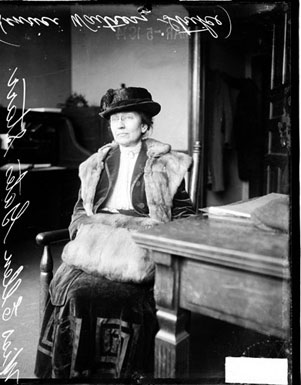
Ellen Gates Starr was born in Laona, Ill., on March 19, 1859. She was a student at the Rockford Female Seminary (1877-78), where she met Jane Addams; their friendship lasted many years. Some historians have suggested that Starr was a lesbian who had a relationship with Addams. Starr taught for ten years in Chicago and Mount Morris, Ill., before joining Addams in 1888 for a tour of Europe. While in London, they were inspired by the success of the English Settlement movement and became determined to establish a similar social settlement in Chicago, where Starr had been teaching.
They found an old mansion that had become used for storage, originally owned by the Hull family – thus, Hull House. They took up residence on September 18, 1889, and began “settling” in with the neighbors, to experiment with how to best serve the people there, mostly poor and working class families.
Starr led reading groups and lectures, on the principle that education would help uplift the poor and those who worked at low wages. She taught labor reform ideas, but also literature and art. She organized art exhibits. In 1894, she founded the Chicago Public School Art Society to get art into public school classrooms. She traveled to London to learn bookbinding, becoming an advocate for the handicrafts as a source of pride and meaning. She tried to open a bookbindery at Hull House, but it was one of the failed experiments.
Starr also read such authors as Charles Dickens and John Ruskin, and began shaping her own ideas about labor and other social reforms. She became more involved in labor issues in the area, involving immigrants, child labor and safety in the factories and sweatshops in the neighborhood.
In 1896, Starr joined the garment workers’ strike in support of the workers. She was a founding member of the Chicago chapter of the Women’s Trade Union League (WTUL) in 1904. In that organization, she, like many other educated women, worked in solidarity with the often-uneducated women factory workers, supporting their strikes, helping them file complaints, raising funds for food and milk, writing articles and otherwise publicizing their conditions to the wider world.
In 1914, in a strike against Henrici Restaurant, Starr was among those arrested for disorderly conduct. She was charged with interfering with a police officer, who claimed she had used violence against him and “tried to frighten him” by telling him to “leave them girls be!” She, a frail woman of at best a hundred pounds, did not look to those in court like someone who could frighten a policeman from his duties, and she was acquitted.
Starr joined the Socialist Party in 1911 and was a candidate in the 19th ward for the alderman’s seat on the Socialist ticket. As a woman and a Socialist, she did not expect to win, but used her campaign to draw connections between her Christianity and Socialism, and to advocate for more fair working conditions and treatment of all. She was active with the Socialists until 1928.
Addams and Starr disagreed about religion, as Starr moved from her Unitarian roots in a spiritual journey that took her to conversion to Roman Catholicism in 1920.
She withdrew from public view as her health grew poorer. A spinal abscess led to surgery in 1929, and she was paralyzed after the operation. Hull House was not equipped or staffed for the level of care that she needed, so she moved to the Convent of the Holy Child in Suffern, N.Y. She was able to read and paint and maintain a correspondence, remaining at the convent until her death in 1940.
Photo: Ellen Gates Starr in 1914 (Chicago Daily News/Wikipedia).










